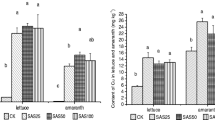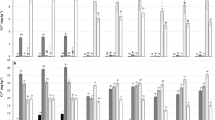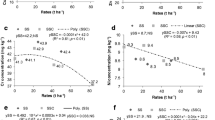Abstract
Sewage sludge may be used as an agricultural fertilizer, but the practice has been criticized because sludge may contain trace elements and pathogens. The aim of this study was to compare the effectiveness of total and pseudototal extractants of Cu, Fe, Mn, and Zn, and to compare the results with the bioavailable concentrations of these elements to maize and sugarcane in a soil that was amended with sewage sludge for 13 consecutive years and in a separate soil that was amended a single time with sewage sludge and composted sewage sludge. The 13-year amendment experiment involved 3 rates of sludge (5, 10, and 20 t ha−1). The one-time amendment experiment involved treatments reflecting 50, 100, and 200 % of values stipulated by current legislation. The metal concentrations extracted by aqua regia (AR) were more similar to those obtained by Environmental Protection Agency (EPA) 3052 than to those obtained by EPA3051, and the strongest correlation was observed between pseudo(total) concentrations extracted by AR and EPA3052 and bioavailable concentrations obtained by Mehlich III. An effect of sewage sludge amendment on the concentrations of heavy metals was only observed in samples from the 13-year experiment.
Similar content being viewed by others
References
Agazzi, A., & Pirola, C. (2000). Fundamentals, methods and future trends of environmental microwave sample preparation. Microchemical Journal, 67, 337–341. doi:10.1016/S0026-265X(00)00085-0.
Alloway, B. J., & Jackson, A. P. (1991). The behaviour of heavy metals in sewage sludge-amended soils. The Science of the Total Environment, 100, 151–176. doi:10.1016/0048-9697(91)90377-Q.
Antoniadis, V., Tsadilas, C. D., & Samaras, V. (2010). Trace element availability in a sewage sludge-amended cotton grown Mediterranean soil. Chemosphere, 80, 1308–1313. doi:10.1016/j.chemosphere.2010.06.047.
Brun, L. A., Maillet, J., Richarte, J., Herrmann, P., & Remy, J. C. (1998). Relationships between extractable copper soil properties and copper, uptake by wild plants in vineyard soils. Environmental Pollution, 102, 151–161. doi:10.1016/S0269-7491(98)00120-1.
Chen, M., & Ma, L. Q. (1998). Comparison of four USEPA digestion methods for trace metals analysis using certified and Florida soils. Journal of Environmental Quality, 27, 1294–1300.
Environmental National Council—CONAMA (2009) Resolution no 420 of December 28, 2009. Provides criteria and guiding values of soil quality regarding presence of chemicals and establishes guidelines for environmental management of areas contaminated by these substances resulting from human activities. Accessed on 21 Oct 2011.
Gheju, M., Pode, R., & Manea, F. (2011). Comparative heavy metal chemical extraction from anaerobically digested biosolids. Hydrometallurgy, 108, 115–121. doi:10.1016/j.hydromet.2011.03.006.
Harris, D. C. (1999). Quantitative chemical analysis. 5.ed. LTC. Rio de Janeiro, 150–167. (in Portuguese)
Harter, R. D. (1991). Micronutrient adsorption–desorption reactions in soils. In R. J. Luxmoore (Ed.), Micronutrients in agriculture (pp. 59–88). Madison: SSSA Inc.
Kabala, C., Karczewska, A., Szopka, K., & Wilk, J. (2011). Copper, zinc, and lead fractions in soils long-term irrigated with municipal wastewater. Communications in Soil Science and Plant Analysis, 42, 905–919. doi:10.1080/00103624.2011.558960.
Lu, Y., Zhu, F., Chen, J., Gan, H., & Guo, Y. (2007). Chemical fractionation of heavy metals in urban soils of Guangzhou, China. Environmental Monitoring and Assessment, 134, 429–439. doi:10.1007/s10661-007-9634-1.
Lucho-Constantino, C. A., Prieto-Garcia, F., Del Razo, F. M., Rodriguez-Vazquez, R., & Poggi-Varaldo, H. M. (2005). Chemical fractionation of boron and heavy metals in soils irrigated with wastewater in central Mexico. Agriculture, Ecosystems and Environment, 108, 57–71. doi:10.1016/j.agee.2004.12.013.
Mandal, B., Hazra, G. C., & Mandal, L. N. (2000). Soil management influences of zinc desorption for rice and maize nutrition. Soil Science Society of America Journal, 64, 1699–1705.
McBride, M. B. (1994). Environmental chemistry of soils (p. 406p). Oxford: Oxford University Press Inc.
McGrath, S., & Cunliffe, C. H. (1985). A simplified method for the extraction of the metals Fe, Zn, Cu, Ni, Cd, Pb, Cr, Co and Mn from soils and sewage sludges. Journal of the Science of Food and Agriculture, 36, 794–798. doi:10.1002/jsfa.2740360906.
Mehlich, A. (1984). Mehlich-3 soil test extractant: a modification of Mehlich-2 extractant. Communications in Soil Science and Plant Analysis, 15, 1409–1416. doi:10.1080/00103628409367568.
Metzger, L., & Yaron, B. (1987). Influence of sludge organic matter on soil physical properties. Advances in Soil Sciences, 7, 141–163.
National Institute of Standards and Technology (2002). Standard Reference Materials—SRM 2709, 2710 and 2711. Addendum issue date: 18 Jan.
Nieuwenhuize, J., Poley-Vos, C. H., van den Akker, A. H., & van Delft, W. (1991). Comparison of microwave and conventional extraction techniques for the determination of metals in soils, sediment and sludge samples by atomic spectrometry. The Analyst, 116, 347–351. doi:10.1039/AN9911600347.
O’Connor, G. A., Sarkar, D., Brinton, S. R., Elliott, H. A., & Martin, F. G. (2004). Phytoavailability of biosolids phosphorus. Journal of Environmental Quality, 33, 703–712.
Renner, R. (2000). Sewage sludge, pros & cons. Environmental Science and Technology, 34, 430–435.
SAS Institute. (2002). SAS: user’s guide statistics (6th ed.). Cary: Institute.
Shrivastava, R., Upreti, R. K., & Chaturvedi, U. C. (2003). Various cells of the immune system and intestine differ in their capacity to reduce hexavalent chromium. FEMS Immunology and Medical Microbiology, 38, 65–70. doi:10.1016/S0928-8244(03)00107-X.
Sparks, D. L. (1995). Sorption phenomena on soils. In D. L. Sparks (Ed.), Environmental soil chemistry (pp. 99–139). California: San Diego.
Sukreeyapongse, O., Holm, P. E., Strobel, B. W., Panichsakpatana, S., Magid, J., & Hansen, H. C. B. (2002). pH-dependent release of cadmium, copper, and lead from natural and sludge-amended soils. Journal of Environmental Quality, 31, 1901–1909. doi:10.2134/jeq2002.1901.
Teixeira, S. T., Melo, W. J., & Silva, E. T. (2005). Heavy metals in a degraded soil treated with sludge from water treatment plant. Scientia Agricola, 62, 498–501. doi:10.1590/S0103-90162005000500016.
USEPA (United States Environmental Protection Agency) (1996). Method 3052: microwave assisted acid digestion of siliceous and organically based matrices (compact disc). Washington.
USEPA (United States Environmental Protection Agency) (1998). In: SW-846: test methods for evaluating solid waste, physical and chemical methods. Washington.
USEPA (United States Environmental Protection Agency) (1999). Biossolids generation, use, and disposal in the United States. Washington.
Ure, A. M. (1995). Methods of analysis for heavy metals in soils. In B. J. Alloway (Ed.), Heavy metals in soil (2nd ed., pp. 58–102). Glasgow: Blackie Academic & Professional.
Väisänen, A., & Suontamo, R. (2002). Comparison of ultrasound-assisted extraction, microwave assisted acid leaching, and reflux for the determination of arsenic, cadmium, and copper in contaminated soil samples by electrothermal atomic absorption spectrometry. Journal of Analytical Atomic Spectrometry, 17, 739–742. doi:10.1039/B202534P.
Wong, J. W. C., Li, K. L., Zhou, L. X., & Selvam, A. (2007). The sorption of Cd and Zn by different soils in the presence of dissolved organic matter from sludge. Geoderma, 137, 310–317. doi:10.1016/j.geoderma.2006.08.026.
Acknowledgments
We thank the São Paulo State Research Support Foundation (FAPESP) for a Ph.D. grant awarded to the first author, and Brazil’s National Council on Scientific and Technological Development (CNPq) for a research grant provided to the second and fourth authors. The third author was funded by CNPq Project Grant no. 575025/2008-5.
Author information
Authors and Affiliations
Corresponding author
Rights and permissions
About this article
Cite this article
Nogueirol, R.C., de Melo, W.J., Bertoncini, E.I. et al. Concentrations of Cu, Fe, Mn, and Zn in tropical soils amended with sewage sludge and composted sewage sludge. Environ Monit Assess 185, 2929–2938 (2013). https://doi.org/10.1007/s10661-012-2761-3
Received:
Accepted:
Published:
Issue Date:
DOI: https://doi.org/10.1007/s10661-012-2761-3




